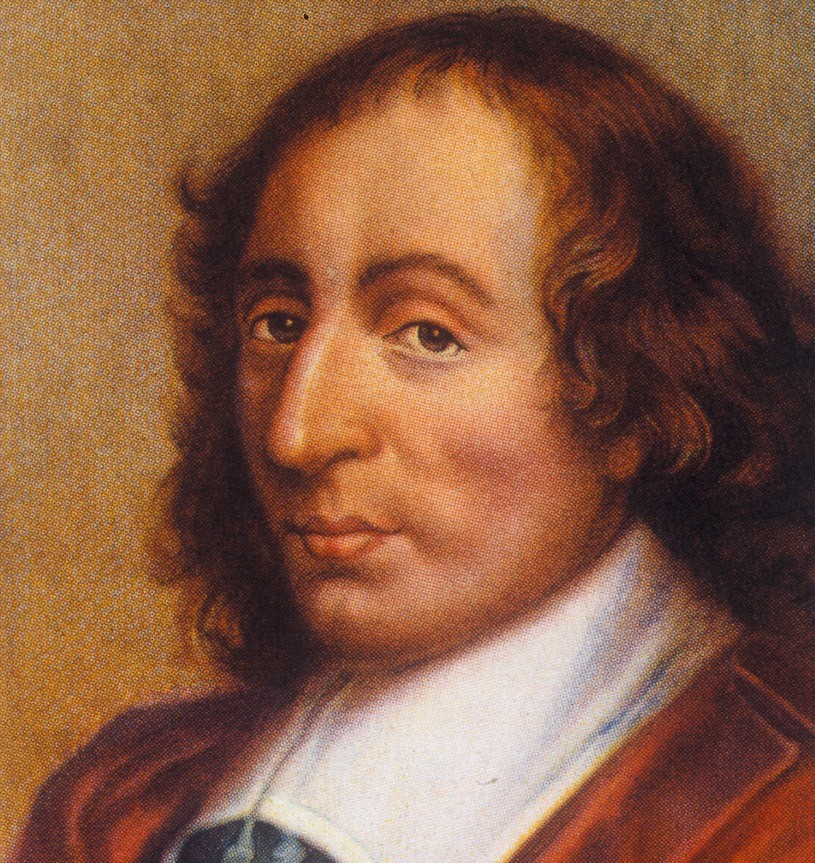Source: http://www.biography.com/people/blaise-pascal-9434176#synopsis
Early Life
Inventor, mathematician, physicist and theological writer Blaise Pascal, born on June 19, 1623
in Clermont-Ferrand, France, was the third of four children and only son to Etienne and Antoinette Pascal. His mother, Antoinette, passed away when he was just a toddler. He was exceptionally close to his two older sisters, Gilberte and Jacqueline. His father, Etienne, was a tax collector and a talented mathematician.
Etienne moved the family to Paris in 1631. There, he decided to educate Blaise—a child prodigy—himself so he could design his own unorthodox curriculum and make sure that Blaise didn't work too hard. Ironically, Etienne entirely omitted mathematics from Blaise’s early curriculum. Etienne was concerned that Blaise would become so fascinated with geometry that he wouldn’t be unable to focus on classical subjects.
The beginning of Blaise’s education in Paris was geared toward languages, especially Latin and Greek. Even so, Etienne's plan backfired: The fact that mathematics was a forbidden topic made the subject even more interesting to the inquisitive boy, who at the age of 12 began exploring geometry on his own. He even made up his own terminology, not having learned the official terms. The prodigy quickly managed to work out that the sum of a triangle's angles are equal to two right angles.
Etienne was impressed. In answer to Blaise's unswerving fascination, his father permitted him to read Euclid. Etienne also at last allowed Blaise to accompany him to meetings at the mathematics academy in Paris. It was there, at age 16, that Blaise presented a number of his early theorems, including his "mystical hexagon." Blaise could not have asked for a better audience; in attendance were some of the premier mathematical thinkers of the time, including Marin Mersenne, Pierre Gassendi and Clyde Mydorge, to name a few.
In 1640, the Pascal family drew up stakes once again. They moved to Rouen, France, where Blaise's father had been appointed to collect taxes. Within just a year of moving, Blaise published his first written work, Essay on Conic Sections. The essay constituted an important leap forward in projective geometry, which involved transferring a 3-D object onto a 2-D field.
In 1646, Etienne was seriously injured in an accident that rendered him housebound. The accident created a shift in the whole family's religious beliefs. The Pascals had never fully embraced the local Jesuits' ideas. After Etienne's accident, a visit from a group of Jansenists led the family to convert to that belief system. During the year that Etienne convalesced, two Jansenist brothers watched over Blaise. As a result of their influence, Blaise became devoutly religious.
Inventions and Discoveries
A true trailblazer and a child prodigy to boot, Blaise Pascal started his prolific stream of groundbreaking inventions and discoveries when he was still just a teen.
In 1642, at age 18, inspired by the idea of making his father's job of calculating taxes easier, Pascal invented an early calculator, dubbed the Pascaline. (German polymath William Schickard had developed and manufactured an earlier version of the digital calculator in 1624.) The Pascaline was a numerical wheel calculator with eight movable dials, each representing a numerical digit, such as ones, tens and hundreds. It was capable of adding, subtracting, multiplying and dividing.
Pascal's invention was not without its glitches: There was a discrepancy between the calculator's design and the structure of the French currency of the time. The machines went into production in 1642, but Pascal continued to work on improving his calculator until 1645. (Fifty prototypes had been produced by 1652, but the Pascaline was never a big seller. It went out of production less than a year later.)
In 1648, eight years after his first essay was published, Pascal starting writing more of his theorems on conic sections in The Generation of Conic Sections, but he pushed the work aside until 1654.
At the end of the 1640s, Pascal temporarily focused his experiments on the physical sciences. Following in Evangelista Torricelli’s footsteps, Pascal experimented with how atmospheric pressure could be estimated in terms of weight. By taking readings of the barometric pressure at various altitudes, Pascal validated Torricelli's theory concerning the cause of barometrical variations.
In the 1650s, Pascal set about trying to create a perpetual motion machine, the purpose of which was to produce more energy than it used. In the process, he stumbled upon an accidental invention. In 1655, Pascal's roulette machine was born. Aptly, he derived its name from the French word for "little wheel."
Overlapping his work on the roulette machine was Pascal's correspondence with mathematical theorist Pierre de Fermat, beginning in 1654. Through their letters discussing dice problems, and through Pascal's own experiments, Pascal discovered that there is a fixed likelihood of any certain outcome when it comes to the roll of the dice. This discovery was the basis of the mathematical theory of probability, the eye-opening realization that events and their outcomes did not occur randomly.
Although the specific dates are uncertain, Pascal also reportedly invented a rather primitive form of the wristwatch. It was an informal invention to say the least: The mathematician was known to strap his pocket watch to his wrist with a piece of string, presumably for the sake of convenience while tinkering with his other inventions.








